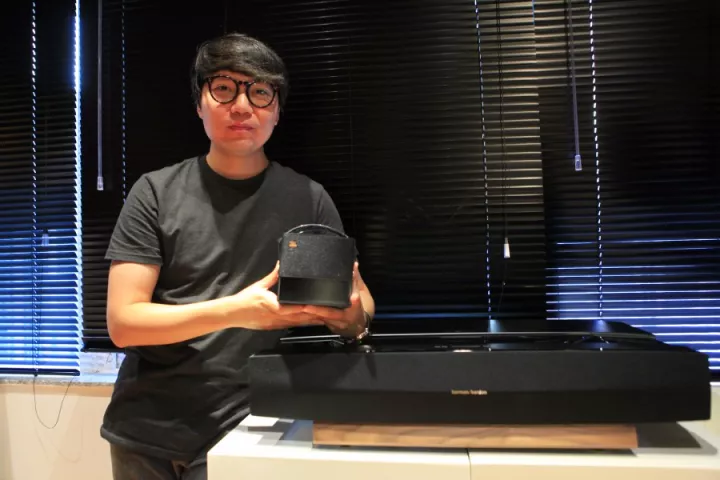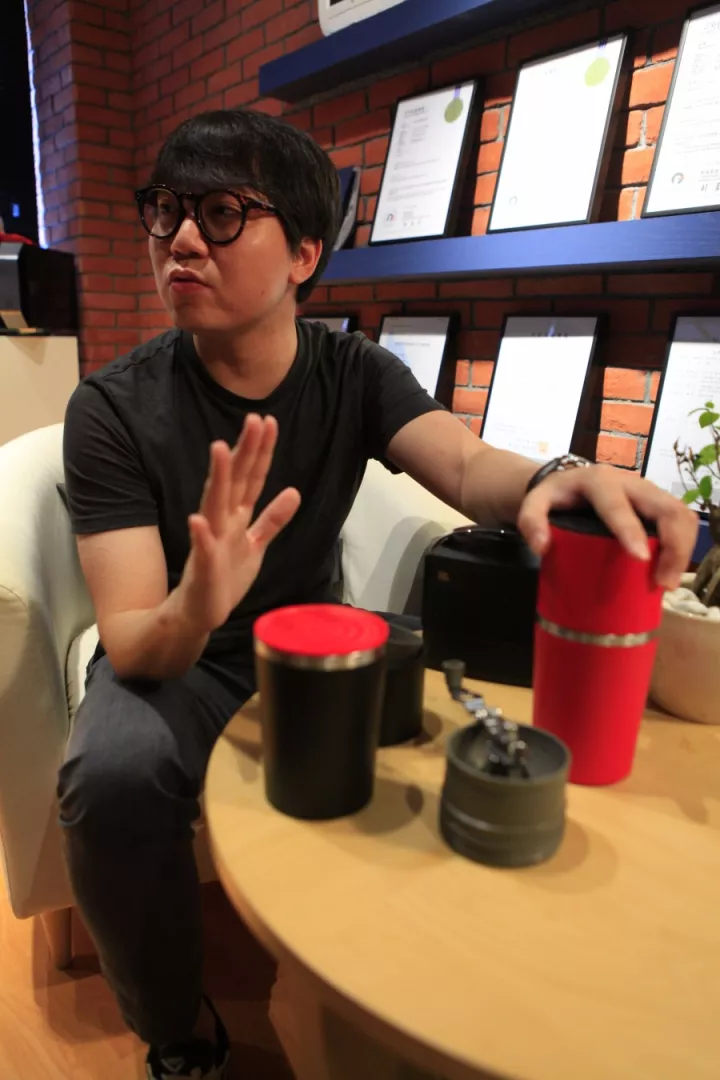South Korean designer starts anew in Futian
Being a good industrial designer means prioritizing user experience and being considerate of users, according to Lee Youn-gu, a 31-year-old industrial designer from South Korea.

Lee Youn-gu and a portable projector he designed. Photos by Sun Yuchen
Lee is the design director of JDW’s Shenzhen branch based in Futian District. JDW is a South Korean design company that was founded eight years ago, and its Shenzhen branch was launched in 2014. Lee has worked as an industrial designer since 2008 and he joined JDW’s Shenzhen branch two and a half years ago.
“At the beginning I just wanted to design products in the way I liked, but then I realized that as an industrial designer I should design products based on the users’ needs,” he said. In his view, user-friendly details should always be prioritized by industrial designers.
Lee and his colleagues in Shenzhen have won many international design awards. A projector designed by Lee and his team for a Chinese company won the Red Dot Award and iF Product Design Award this year.
He said some design companies only care about designing good-looking products but they don’t consider whether the products are feasible for mass production. “What we are doing at JDW is coordinating with our customers and designing the products in a practical and economical way,” Lee said.
According to Lee, industrial designers go through four stages in their careers. In the first and second stages, they copy other designers and redesign their products. In the third stage, they digest what they have learned from others and express it in their own way. In the final stage, they develop their own design habits and personal styles.
Lee said he is still in the third stage and he is looking forward to entering the final stage.
Although Lee gained an abundance of experience as an industrial designer when he worked in South Korea, he felt that everything started anew after he came to Shenzhen. He sometimes has to design things that he has never seen or used before due to the cultural gap between the two countries.
For instance, he did a lot of research when designing a kitchen ventilator for a Chinese home appliance brand. Ventilators to dispel smoke from kitchens are commonly seen in Chinese households, but they were a totally new thing for Lee. “I’d never seen a kitchen ventilator before I came to China because we don’t use them in South Korea,” he said.
Lee said his career has taken a big step forward since he moved to Shenzhen, because he has learned a lot from the Chinese culture. In his eyes, Shenzhen is a magical city that integrates different cultures together. “Shenzhen is a migrant city and people from different places have also brought their regional cultures to this city,” he said.
Lee feels that as an industrial designer he is offered more freedom to use his creativity and realize his ideas in Shenzhen than in South Korea.
He said many customers in South Korea are reluctant to spend money on industrial design as they want to control the costs, but there are lots of big companies in Shenzhen and they are mostly product-oriented and are willing to spend more on product design.
Like other designers, Lee and his colleagues have also been bothered by copycats who violate their intellectual property rights (IPRs).
The company designed an all-in-one coffee maker for a foreign brand two years ago. It was the world’s first portable pour-over coffee maker, with a foldaway hand-mill grinder that allows users to grind the coffee beans with their own hands.

The world’s first portable pour-over coffee maker with a foldaway hand-mill grinder designed by Lee and his colleagues.
“We brought the coffee maker to the Canton Fair in Guangzhou for an exhibition two years ago. But five months later, our client asked if we had sold the design blueprint to other customers because they had found similar coffee makers on the market,” he said.
Lee said they couldn’t do anything to stop the copycats. “What we can do is ensure the quality of our product so that users are able to distinguish our coffee maker from the counterfeits,” he said.
According to Lee, protecting IPR is a global challenge as copycats can exist in any country. He is delighted to see that more people in China are paying attention to IPR protection and the government is putting more effort into protecting original design in the country.
Lee said he felt some complicated emotions when he found out his design was being copied. He felt both upset and proud because being copied means that his design was recognized and appreciated by others. “Quality is the key thing that a designer should defend to ensure that his works are always better than the counterfeits,” he said.
The customers of JDW’s Shenzhen branch are mostly Chinese companies, with products ranging from air-conditioners and washing machines to water purifiers and milk makers. According to Lee, JDW is also planning to set up more branches in other Chinese cities.